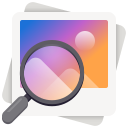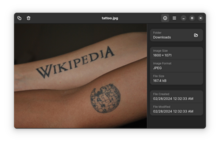 | |
 Loupe 45.3 displaying an image | |
| Stable release | 47.2 [1] / 22 November 2024 |
|---|---|
| Repository | gitlab |
| Written in | Rust |
| Operating system | Linux |
| Included with | GNOME |
| Predecessor | Eye of GNOME |
| License | GNU General Public License version 3 |
| Website | apps |
Loupe, also known as Image Viewer, is an image viewer created for the GNOME desktop environment. It first appeared on December 26, 2020. [2] With the GNOME 45 update, Loupe became GNOME's default image viewer, replacing Eye of GNOME. [3] [4]
Contents
Like its predecessor, Loupe offers various options for viewing images. These include standard options such as zooming, rotation, and transparency. Other features include touchscreen support, metadata info, and sandboxed decoding.